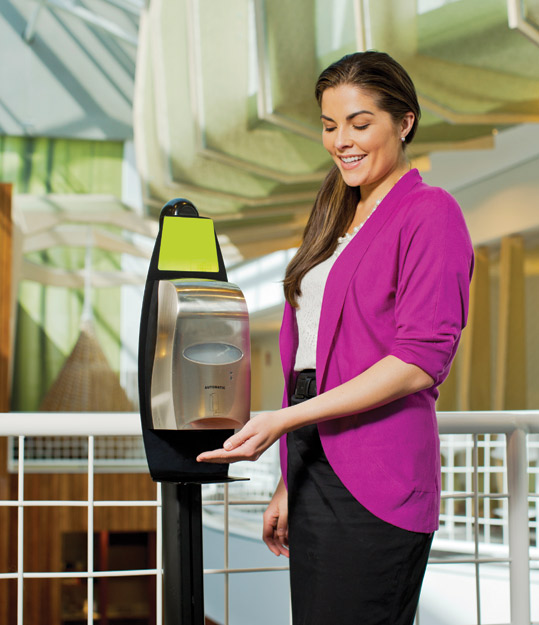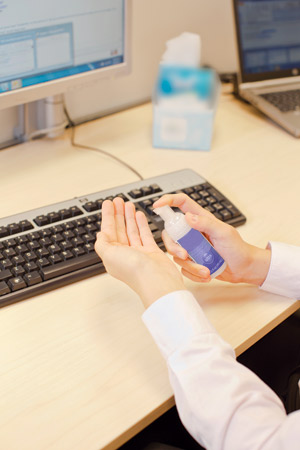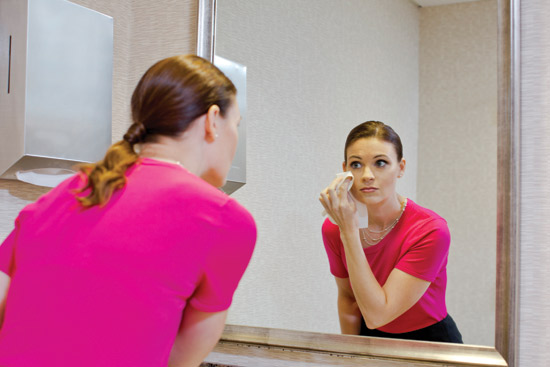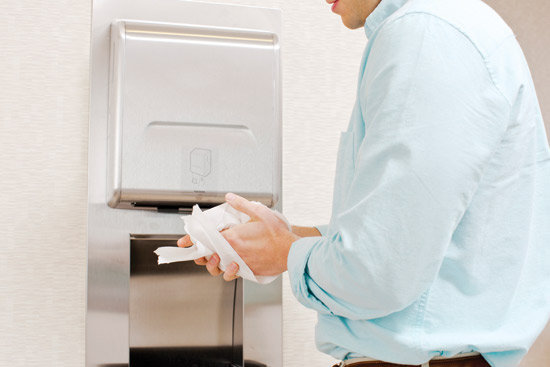Looking Good: New Paper Towel Dispenser Systems Score in Appearance, Sustainability, and User Preference
The importance of solutions that foster occupant health is underscored by research that shows that 98 percent of workers are affected by minor illness each year2 and 80 percent of minor illnesses are preventable.3 One contributing factor could be highly concentrated work environments often have high levels of germs. Viruses can live from 20 minutes to 2 hours on surfaces, including chairs, tables, and vending machines.4 Common areas are perfect sanctuaries for unwanted germs—water coolers, ATMs, door handles, conference tables, reception areas. Adults touch their faces an average of 15.7 times every hour,5 transmitting germs to the surfaces they subsequently touch. Handshakes can transmit viruses far beyond the hands of the person being greeted, including people outside the actual office.
Naturally, it is no surprise that a public restroom is another hot spot for germs. Florida researchers cultured four commercial aircraft and 18 restrooms,6 including those in a mall, hospital, offices, lecture hall, conference center, department stores, restaurants, airport, and resort. According to the study, “Faucets, soap and paper dispenser operating levers, and the exit door handle of restaurants and aircraft restrooms were more likely to have concentrations of microorganisms too numerous to count compared with other locations.” The study further found that “Cultures of high-touch sites in three restrooms located in different areas of a tertiary care hospital yielded six microorganisms that are responsible for two-thirds of healthcare-associated infections.”7
Personal hygiene habits have a direct correlation with contracting minor illnesses, particularly during flu season, and some companies have adopted the three-step approach of hand washing, wiping, and sanitizing as a way to keep workplace illnesses at bay. As has been published widely in the medical literature, proper hand washing is still the best way to reduce the spread of germs. Using disinfectant wipes kills germs on some of the dirtiest hot spots, such as doorknobs, keyboards, and phones. The third line of defense is to use hand sanitizer—it kills 99.9 percent of germs, and can reduce sick days by 21 percent in office environments.

Photo courtesy of KIMBERLY-CLARK PROFESSIONAL*
Using hand sanitizer kills 99.9 percent of germs* and can reduce sick days by 21 percent in office environments.
*Instant hand sanitizer kills 99.9% of germs in as little as 15 seconds.
While personal hygiene habits do reduce minor illness, architects and owners are concerned with building for high-traffic areas and controlling potential public health issues. Of prime importance are solutions that combine functional design with health and waste reduction goals.

Photo courtesy of KIMBERLY-CLARK PROFESSIONAL*
There are several germ “hot spots” throughout a typical office space.
Restrooms—A Key Component of Healthy Public Spaces
While in times past, public restrooms were not a major focus of attention, today the concern with curtailing the spread of germs and disease has made having safe and sanitary restrooms a must for any establishment. An unsightly appearance of the restrooms in a restaurant, hospital, school, office building can create the perception of uncleanliness throughout the rest of the facility. Patrons may be enthusiastic about the food in a restaurant or visitors may be impressed with a hotel's ambience, for example, but if they see wet floors or unclean conditions in the restroom, they may question the sanitary standards of the entire operation. Faced with these conditions, users may not wipe their hands adequately, or forego hand washing altogether. On the other hand, modern and clean restrooms are an opportunity to enhance and improve the image of a facility. For example, an opera house might have nice cloth towels and exceptional features and a contemporary university student center restroom would have clean modern lines and the same high-end look as the rest of the facility.
One key way that facility managers are upgrading their restrooms for minimal to no incremental investment is through touchless operation technologies. Consumers do not want to touch surfaces, buttons, or knobs that have been repeatedly handled by others, and have been shown to harbor germs for hours. Manufacturers have responded with faucets, sinks, dryers, and toilets that operate automatically, and facility managers seeking improved hygiene, better image of the restroom, and reduced consumption of natural resources have increasingly invested in their products. Accordingly, automatic touchless operation has virtually become the norm in today's high-traffic public restrooms.8 Earlier models had limited battery life which frustrated maintenance teams and users alike, but newer technologies offer AC power or innovative dispensing technology capable of two to four times the traditional battery life span. Newer models have a more stylish look, too, creating a more upscale restroom while advancing the environmental agenda as toilets, sinks, and hand-drying mechanisms reduce consumption and save resources by allowing patrons to use only what is necessary.
New towel and skincare systems are more hygienic by eliminating touch points and controlling the dispenser to minimize waste. Foam skincare products reduce product usage and provide the same benefits of liquid. Further, recyclable plastic cartridges are more hygienic than their “refillable” counterparts since the refill systems are prone to bacteria growth.

Photo courtesy of KIMBERLY-CLARK PROFESSIONAL*
Well-maintained restrooms can enhance and improve the image of a facility.
Widely regarded as the most hygienic approach, touchless products when installed properly have also been recognized as Americans with Disability Act (ADA) compliant and consistent with universal design standards, now a LEED-sanctioned feature. It is important to note, however, that appropriate maintenance protocols remain a key part of keeping restrooms, touchless or otherwise, up to desired criteria.










